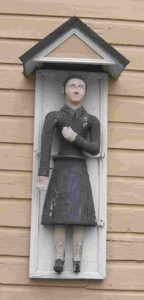From an article by Anja Smolander.
Translated by June Pelo.

Since the time of the 1600’s there were hundreds of carved wooden figures of old men that stood outside the churches in Österbotten. They were called poor old men and stood there with an appealing expression on their faces and a hand over their heart, or stretched out for alms, imploring the parish to remember the needy and invalids.
In the 1700’s and 1800’s it was customary for people to put money in an opening in his chest – alms for the needy. Each parish divided the money among those who were most needy. The biblical passage moved even the hardest heart: “He who gives to the poor shall not want.”
Over the years many of the “poor men” stood neglected in a corner of the church, but during recent times they have been cleaned, painted and put back near the old place outside the church doorway. Most of the 120 old men that were preserved were carved in the 1800’s when Finland experienced relative prosperity.
The oldest ones are from the 1600’s. The poor old man in Brahestad’s museum represents a human money chest, while the later old men represented a disabled soldier who had lost a leg. At the beginning of the 20th century over 100 old men still remained when communities began to take responsibility for the needy and sick. The poor old men had lost their importance, but were allowed to remain as church guardians.
Later they were looked on with great interest. Different forms of art are found in other lands, but they did not have nearly the religious statement as did these old men. Who carved these noteworthy old men? The skilled carpenters of the parish were allowed to make the old men, provided they lived a fairly decent life and did not drink much. Some of them were the builders who built the wooden churches. Some of the carpenters were Heikki Mikkilä, Johan Bergman and Mårten Lassus.
The old men differed from each other depending on where they were located. In southern Ostrobothnia the little old man was carved without headgear. Farther to the north the old men were larger and free standing. In northern Ostrobothnia the figures were large and impressive with hats on their heads. The view held by the well-off was not always one of disinterest for the needy.
When the church bell rang for worship, even the worst skinflint lightened his purse because the poor widow in front of him had given her pitiful sum with a grateful heart. Sometimes people gave the poor old man a gift, hoping for fulfillment.
Zachris Topelius’ saga tells about a poor old man named Tra-Per in Lochteå and of some prison fugitives who attempted to steal him. It’s a true story. In olden times the poor old men were respected because people believed that anyone who wronged them would be punished. There is an old tale in Vindala about a drunken man who sang a drinking song and tried to dance with the poor old man. It wasn’t long before he was paralyzed and couldn’t say anything except “toot, toot, toot.”